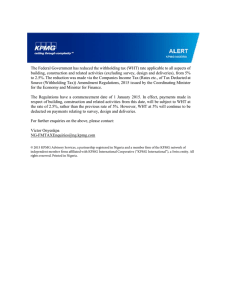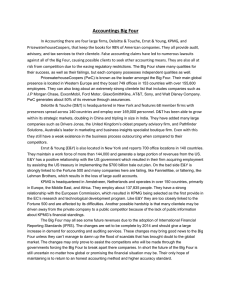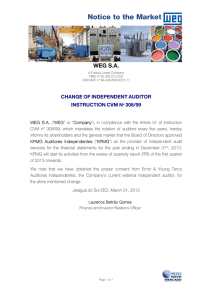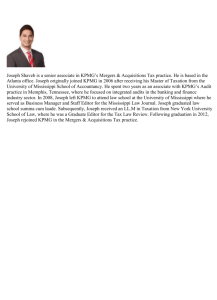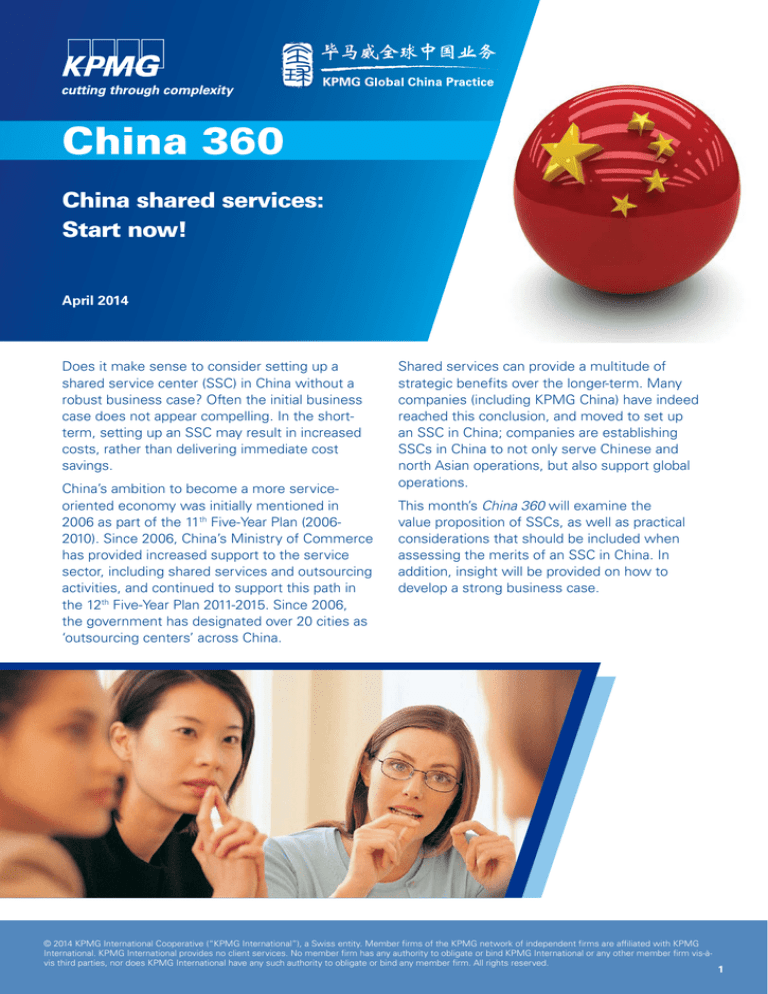
China 360
China shared services:
Start now!
April 2014
Does it make sense to consider setting up a
shared service center (SSC) in China without a
robust business case? Often the initial business
case does not appear compelling. In the shortterm, setting up an SSC may result in increased
costs, rather than delivering immediate cost
savings.
China’s ambition to become a more serviceoriented economy was initially mentioned in
2006 as part of the 11th Five-Year Plan (20062010). Since 2006, China’s Ministry of Commerce
has provided increased support to the service
sector, including shared services and outsourcing
activities, and continued to support this path in
the 12th Five-Year Plan 2011-2015. Since 2006,
the government has designated over 20 cities as
‘outsourcing centers’ across China.
Shared services can provide a multitude of
strategic benefits over the longer-term. Many
companies (including KPMG China) have indeed
reached this conclusion, and moved to set up
an SSC in China; companies are establishing
SSCs in China to not only serve Chinese and
north Asian operations, but also support global
operations.
This month’s China 360 will examine the
value proposition of SSCs, as well as practical
considerations that should be included when
assessing the merits of an SSC in China. In
addition, insight will be provided on how to
develop a strong business case.
© 2014 KPMG International Cooperative (“KPMG International”), a Swiss entity. Member firms of the KPMG network of independent firms are affiliated with KPMG
International. KPMG International provides no client services. No member firm has any authority to obligate or bind KPMG International or any other member firm vis-àvis third parties, nor does KPMG International have any such authority to obligate or bind any member firm. All rights reserved.
1
Global Business Services (GBS)
refers to strategically aligning a company’s
regional shared services (internal captive
center(s) and outsourcing relationships)
to create a ‘global’ delivery model that
tactically aligns activities.
Companies in China should be
looking into how they ‘fit’ into their
organization’s GBS strategy
GBS structure
Global Business Services is
stragically aligning regional
shared services to
‘add value’ and separate
GBS
Organization
from their competitors
Shared services have
been regionally focused
to support both delivery
Shared
Services
models below
be an internal or
organization
Chinese companies that have established shared
services include: Tencent, China General Nuclear
Power Cooperation, Guangzhou Power Bureau, and
ZTE. They have all set up various back office functions
to support their strategic growth initiatives.
“
Shared services can
external part of your
According to HFS research over 75 percent1 of
Fortune 500 companies have adopted some form
of shared services. Many of these organizations
have evolved into a Global Business Services (GBS)
strategy to obtain additional value. GBS has become
a key pillar in many companies, including Procter &
Gamble, Nestle, and Citigroup, with the head of GBS
typically occupying a seat next to the CFO, CIO, or
CPO of their respective organizations.
Internal
Captive Center
Outsourcing
(Third Party)
The resource pool in China is fantastic
for shared services. I’ve set up centers all
over the world, and the ability for the
workforce here to follow regimented
processes and work in a shared service
environment is outstanding.
– Gary P. Nowak
Director, KPMG Management Consulting
1. HFS is ‘Horses for Sources’. KPMG US LLP has a strategic alliance with HFS.
© 2014 KPMG International Cooperative (“KPMG International”), a Swiss entity. Member firms of the KPMG network of independent firms are affiliated with KPMG
International. KPMG International provides no client services. No member firm has any authority to obligate or bind KPMG International or any other member firm vis-àvis third parties, nor does KPMG International have any such authority to obligate or bind any member firm. All rights reserved.
2
Key attributes
of shared services
Organizations initially set up shared services with
the expectation of a positive impact to their bottom
lines, saving companies millions of dollars. After the
savings were incorporated into budgets and future
plans, the focus turned to other valuable attributes
outlined here.
China companies, however, typically won’t find an
initial compelling business case and should focus on
the numerous other ways that shared services can
provide value to an organization. Click on the icons
below to read more..
Support
growth
Accessing thirdparty expertise
Business focus
and flexibility
Data and
analytics
Compliance
and control
The numerous
other ways that
shared services can
provide value to an
organization
?
$
$
Business
outcomes
Reporting
and metrics
Leverage IT
investments
Minimize
operating costs
Talent cost and
retention
© 2014 KPMG International Cooperative (“KPMG International”), a Swiss entity. Member firms of the KPMG network of independent firms are affiliated with KPMG
International. KPMG International provides no client services. No member firm has any authority to obligate or bind KPMG International or any other member firm vis-àvis third parties, nor does KPMG International have any such authority to obligate or bind any member firm. All rights reserved.
3
01
03
Support growth
Businesses in China (both multinationals and
domestic companies) continue to focus on growth,
either organically or through acquisitions. Shared
services can support this growth in a couple of
ways. With shared services in place, not all acquired
company resources will be required and newly
acquired companies can be integrated more quickly:
both of these outcomes would tend to reduce
operating costs.
The US food and beverage company
General Mills Co. has added over 80 new
Haagen Dazs stores in China without
increasing the size of their SSC.2
02
$
Leverage IT investments (ERP, automation)
Creating a critical mass of resources in a single
location allows the ability to automate on a scale
that can create a business case for technology.
For instance, a decentralized organization may not
consider automating accounts payable invoice entry,
whereas an SSC has the scale to obtain business
case justification. Additionally, implementing a new
ERP (enterprise resource planning) system is typically
a catalyst for changing the service delivery model.
Creating shared services and implementing an ERP
typically go ‘hand-in-hand’ as processes normally
need to change with the new system.
04
$
Compliance and control
As their business in China expands, and the
regulatory environment becomes more complex,
organizations continue to be at risk of noncompliance with government regulations. A
trademark benefit of shared services is the
methodical process documentation, which utilizes
process flows and standard operating procedures
to capture control points, information flow and
segregation of duties. This level of rigor provides
chief executives with assurance that regulations
and policies are properly documented, and through
proper reporting, are being consistently followed.
Minimize operating costs
2: James Wu, General Mills Co., VP Finance, Greater China
3: Based on company discussions throughout China, as well as KPMG experience.
There are a number of ways an SSC can assist a
company to reduce operating costs. First, economies
of scale can drive down overall operating costs,
as processes can be made more efficient if they
are centralized, and duplication of effort reduced.
Second, delivering services from a lower cost
location can also reduce costs: businesses in China’s
tier-1 cities can see savings of 15 percent3 or more
by locating services in tier-2 and tier-3 cities. Finally,
establishing business outcomes (see below) can also
contribute to an improved bottom line.
© 2014 KPMG International Cooperative (“KPMG International”), a Swiss entity. Member firms of the KPMG network of independent firms are affiliated with KPMG
International. KPMG International provides no client services. No member firm has any authority to obligate or bind KPMG International or any other member firm vis-àvis third parties, nor does KPMG International have any such authority to obligate or bind any member firm. All rights reserved.
4
05
07
Talent cost and retention
Business outcomes
The cost of quality talent in China is rising each year.
Salary increases in major China cities are growing
above the rate of inflation, with annual wage inflation
exceeding 10 percent according to China’s 12th FiveYear Plan4. Shared services is a proactive way to
manage talent and get the most out of rising salaries,
while creating a structure to accept a high yearly
attrition rate (sometimes reaching over 20 percent)5.
Allowing businesses to focus on high-end value
added services allows an organization to pay a bit
more to those employees, while shared services pay
much lower (but still locally competitive) salaries.
Business outcomes are a level beyond service level
agreements (SLAs). SLAs are based on the concept
of giving assurance that the SSC will perform
functions accurately and timely. Today, however,
Global Business Service organizations are focusing
on business outcomes to impact the bottom line.
Typical business outcomes include reduction in
DSO (Daily Sales Outstanding), increased strategic
sourcing compliance, reduction of reconciling items,
increase in accounts payable days and fewer days
to close the books. GBS organizations increasingly
stress this concept and will want to share in the
benefit of these tangible business improvements.
“
“But for many foreign companies,
things are getting harder (in China). That is
partly because growth is flagging, while
costs are rising. Talented young workers are
getting harder to find, and pay is soaring”
The Economist, January 25th, 2014
06
Reporting and metrics (increased visibility)
Shared services provide increased visibility of
operational metrics and information allowing an
organization to compare common cost components
across locations or business units. Since an SSC
has access to systems and operational data, this
structure is perfectly suited to perform these
functions. Key executives are enabled to improve
their organizations with proper information through
consistent reports and metrics. Providing a single
point of contact to the global HQ organization can
be invaluable to responding to ad hoc requests for
information.
08
?
Data and analytics
The new ‘darling’ of every organization is improving
Data and Analytics capabilities: CEOs are grappling
with how best to grow their business using
information and analytics. Established shared
services or Centers of Excellence (COE) organizations
are a logical choice to build this capability; the key
consideration is the level of talent available who have
the ability to perform this function.
Within China an SSC and COE can logically
be co-located, making a very strong case to
move up the value chain and incorporate some
type of Data and Analytics capabilities.
4. http://www.reuters.com/article/2012/02/08/us-china-economy-jobs-idUSTRE8170DY20120208
5. Based on industry knowledge and speaking with over 50 SSCs and service providers in
over 20 cities worldwide.
© 2014 KPMG International Cooperative (“KPMG International”), a Swiss entity. Member firms of the KPMG network of independent firms are affiliated with KPMG
International. KPMG International provides no client services. No member firm has any authority to obligate or bind KPMG International or any other member firm vis-àvis third parties, nor does KPMG International have any such authority to obligate or bind any member firm. All rights reserved.
5
09
Business focus and flexibility
Transactional processes are the typical foundation
of any shared service center. By ‘removing’ these
activities and locating them in an SSC, the business
can focus on what really matters: top line revenue
growth and increasing margins. In contrast,
activities related to handling vendor complaints,
collecting receivables or managing internal personnel
administration will not directly grow the business. As
companies adopt an SSC strategy, it is imperative to
realign the corporation for success. And in a dynamic
business environment such as in China, an SSC
structure offers the flexibility to adapt to changes in
business models and directional changes within the
organization.
China on the
maturity curve
China is a relative newcomer to Global Business
Services, and although the past few years have seen
rapid development, China’s maturity on the GBS
maturity curve compared to some other developed
economies is, as you would expect, at a much lower
level. Companies in the US have had their hand in
shared services since the early 1990’s and can be at
Level 5: this typically took 12 to 15 years of hard work
and laser-like focus to accomplish.
Below are stages of maturity and attributes at each
stage, in our experience each stage takes two to
three years for companies to accomplish.
KPMG Global Business Services Maturity Model
10
‘Going it alone’ is a tough journey: moving more
quickly up the maturity curve is a challenge that
typically requires third party expertise. In China as
elsewhere, such expertise can be delivered through
relationships established with third party providers in
the areas of technology, consulting services, software
and real estate. Shared services has the ability to
provide the size and scale needed to establish these
strategic third party relationships. KPMG finds that
as companies move up the maturity curve, they tend
to build multiple strategic relationships. KPMG has
been very successful in working with companies and
building these strategic relationships to assist with
their GBS strategy.
Getting a
business case in China
When evaluating a China-based SSC, a positive
business case can result if the potential to provide
services to business units in higher-cost regional or
global locations is considered. Many companies have
located regional SSCs in China to serve China, Japan
and Korea, with Dalian a popular choice for such
SSCs. As China develops deeper competencies, such
as language skills, it will be a very viable alternative
to more mature SSC locations, such as India or the
Philippines.
Business services maturity
Accessing third party expertise
Global Business
Services/
5
Integrated
4
Multi-function shared
services/Optimized
3
2
1
Integrated
Services/Strategic
Critical Point Globally
Functional shared
services/
Rationalized
China Maturity
Decentralized support
functions/Sub-optimized
The journey… Development stages… Time
5
True
Trueend-to-end
end-to-endprocessing
processing
Customer
Customerfocused
focused
High
Highvalue
value
4
High-endprocesses
processes
High-end
Globalprocess
processowners
owners
Global
3
Multi-functionshared
sharedservices
services
Multi-function
Strategicoutsourcing
outsourcing
Strategic
2
Single-functionshared
sharedservices
services
Single-function
Majorityofofbusinesses
businessessupported
supported by
by shared
shared services
services
Majority
1
Decentralizedfunctions
functions
Decentralized
Nooutsourcing
outsourcing
No
© 2014 KPMG International Cooperative (“KPMG International”), a Swiss entity. Member firms of the KPMG network of independent firms are affiliated with KPMG
International. KPMG International provides no client services. No member firm has any authority to obligate or bind KPMG International or any other member firm vis-àvis third parties, nor does KPMG International have any such authority to obligate or bind any member firm. All rights reserved.
6
Locating an SSC
inside the dragon
Finding a shared service center location in China is no
easy task. An SSC is not a temporary or short-term
facility, and given the range of locations across China
there are a variety of options from which to choose.
However, the advantage for China-based SSCs is that
the ‘trail’ has already been blazed and they don’t have
to re-invent the wheel. Once businesses in China
realize the benefits of GBS (as outlined above) they
can follow an established roadmap. The timeframe to
reach a more mature level will be much steeper (i.e.
shorter) since the vision, tools and methodology to
get there are readily accessible.
Gary P. Nowak, a seconded Director to Shanghai
from KPMG in the US, recognizes the opportunity
for businesses in China to build their shared services
capability now.“Companies need to strategically
support future growth and more importantly
build efficiencies to reduce costs and streamline
processes. The day is quickly approaching where
reducing costs will become just as important as
increasing revenue.”
Regional location of major SSCs
and R&D Centers in China
96
54
39
25
15
East
30
13
25
10
Middle West
31
31
14
North
11
When US logistics giant FedEx was evaluating
locations, they chose Wuhan, in the province of
Hubei. For FedEx, an important reason was that
Wuhan has China’s second largest concentration
of universities (behind Beijing); it has eight national
universities, 35 institutions of higher education and
over 800,000 students5 – many possessing strong
language skills.
As China continues to advance up the maturity
curve, it is likely that different cities will emerge
as preferential destinations for specific industry
verticals. For example, Shanghai – despite tier-1 city
status (and costs) – is home to a number of financial
services SSCs due to the nature of Shanghai as a
financial and business center.
Overall, however, there is a trend toward China’s
tier-2 and tier-3 cities. Relatively cheaper cities
like Suzhou, not far from Shanghai, are potentially
attractive locations for companies from a range of
sectors; inland cities, such as Chengdu, are also
home to an increasing number of SSCs. This trend
toward lower tier cities is significantly more rapid
than the more established outsourcing countries,
such as India.
69
66
Costs are clearly one set of considerations: rent,
labor, overhead and how these costs are expected
to rise over time. In addition, however, are many
other factors that should not be overlooked,
including transport; access to resources (are there
large universities and colleges nearby); the IT and
communications infrastructure; proximity to existing
operations; and the business attraction efforts or
incentives provided by local government agencies or
zone management.
11
South
Outsourcing providers
Outsourcing providers
Internal
Captive
Centers
Internal
captive
centers
Centers
R&DR&D
centers
Financial
backback
officeoffice
service
centers
Financial
service
centers
Source: KPMG Research – Inside the Dragon
5. www.amcham-shanghai.org/
© 2014 KPMG International Cooperative (“KPMG International”), a Swiss entity. Member firms of the KPMG network of independent firms are affiliated with KPMG
International. KPMG International provides no client services. No member firm has any authority to obligate or bind KPMG International or any other member firm vis-àvis third parties, nor does KPMG International have any such authority to obligate or bind any member firm. All rights reserved.
7
Representative shared service locations
Dalian has a good technical and financial skill
base and multilingual capabilities due to its
proximity to Japan and Korea.
Chengdu is located in the western
part of China. This city is a growing
“
KPMG recently updated
“Inside the Dragon” which provides detailed
analysis of top locations for SSCs in China.
The 2013 version covers 29 cities, to include
information on quality of living, government
incentives, infrastructure and existing shared
services operations in each location.
destination for shared services focusing
on information technology, digital content
and finance.
Case study:
World’s leading
learning company
A world’s leading learning company, guiding
individuals from pre-school to professional
certifications, had the vision that significant growth
wasn’t possible for them in China without a solid
shared services strategy.
To reach ambitious sales and market share goals in
China, they needed to establish a partner relationship
with a well-established service provider who could
support various functions to include finance and
accounting, human resources, information technology
and procurement.
Foshan is home to KPMG’s new KDC
shared service center and with close proximity
to Guangzhou and Hong Kong is quickly
becoming a popular destination.
Suzhou is very close to Shanghai, has the
natural and physical resources to maintain
service center expansions.
KPMG assisted with a rapid selection process
that evaluated three service providers across 11
evaluation criteria. KPMG established subjective and
objective evaluation methodologies during a 12-week
process and constantly communicated with each
potential service provider to allow them to adjust
where necessary. A contract with a global service
provider was ultimately reached and is currently
transitioning processes in China.
“We have gotten to a really good place with our
service providers thanks to a brilliant process from
KPMG. The star of the show in all this has been
the service provider selection process, with great
communication throughout, lots of evidence-based
data and a true partner in KPMG.”
– Global Chief Operating Officer,
World’s leading learning company
© 2014 KPMG International Cooperative (“KPMG International”), a Swiss entity. Member firms of the KPMG network of independent firms are affiliated with KPMG
International. KPMG International provides no client services. No member firm has any authority to obligate or bind KPMG International or any other member firm vis-àvis third parties, nor does KPMG International have any such authority to obligate or bind any member firm. All rights reserved.
8
Read on...
For all issues of China 360:
Visit www.kpmg.com/cn/China-360
or scan the following QR code:
Contact us
For more information on KPMG and
shared services, contact:
Gary P. Nowak
Director, Management Consulting
KPMG China
Email: gary.nowak@kpmg.com
Tel.: +86 21 2212 3289
Primary contributors:
Case study: KPMG’s
Delivery Center (KDC)
After 20 years in China, KPMG saw the potential
to establish a national SSC to support a growing
network of offices and staff across the country. In
2013, KPMG opened its SSC in the city of Foshan in
Guangdong Province.
KPMG’s Management Consulting practice assisted
throughout a 16-week transition process, establishing
both Service Level Agreements (SLAs) and business
process design.
Thomas Stanley
COO, Global China Practice
KPMG China
Email: thomas.stanley@kpmg.com
Tel.: +86 21 2212 3884
Robert Ritacca
Research Manager, Global China Practice
KPMG China
Email: robert.ritacca@kpmg.com
Tel.: +86 10 8508 5109
The benefits of the KDC to the Firm are numerous.
For our clients, it will enhance quality and delivery
times. For our people, it will free up time for them
to focus on more challenging, value-added work
and provide earlier responsibility and exposure to
clients. For our business, it will improve efficiency by
centralizing and standardizing processes.
– Steven Parker,
Partner and Audit COO, KPMG China
© 2014 KPMG International Cooperative (“KPMG International”), a Swiss entity. Member firms of the KPMG network of independent firms are affiliated with KPMG
International. KPMG International provides no client services. No member firm has any authority to obligate or bind KPMG International or any other member firm vis-àvis third parties, nor does KPMG International have any such authority to obligate or bind any member firm. All rights reserved.
9



